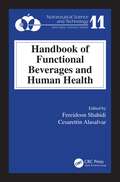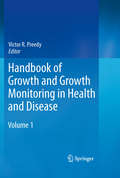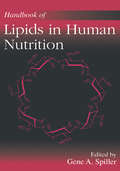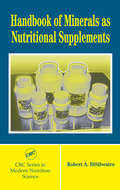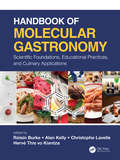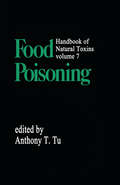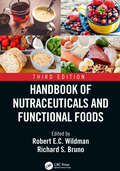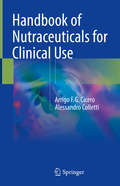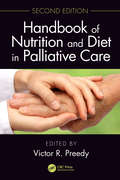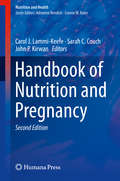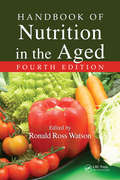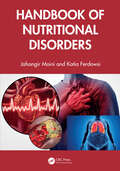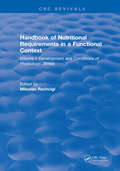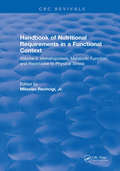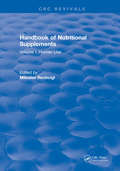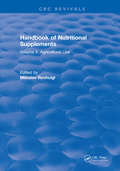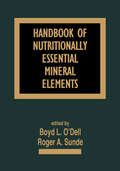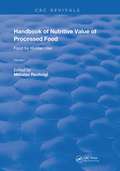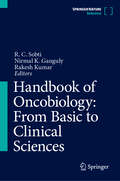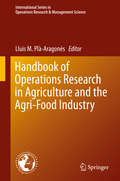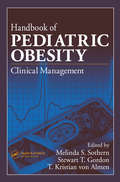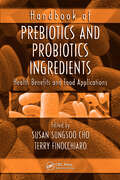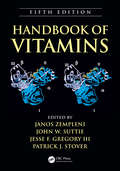- Table View
- List View
Handbook of Functional Beverages and Human Health (Nutraceutical Science and Technology)
by Fereidoon Shahidi Cesarettin AlasalvarHandbook of Functional Beverages and Human Health provides potential applications and new developments in functional beverages, nutraceuticals, and health foods. In addition to serving as a reference manual, it summarizes the current state of knowledge in key research areas and contains novel ideas for future research and development. Additionally,
Handbook of Growth and Growth Monitoring in Health and Disease
by Victor R. PreedyGrowth is one of the human body's most intricate processes: each body part or region has its own unique growth patterns. Yet at the individual and population levels, growth patterns are sensitive to adverse conditions, genetic predispositions, and environmental changes. And despite the body's capacity to compensate for these developmental setbacks, the effects may be far-reaching, even life-long. The Handbook of Growth and Growth Monitoring in Health and Disease brings this significant and complex field together in one comprehensive volume: impact of adverse variables on growth patterns; issues at different stages of prenatal development, childhood, and adolescence; aspects of catch-up growth, endocrine regulation, and sexual maturation; screening and assessment methods; and international perspectives. Tables and diagrams, applications to other areas of health and disease, and summary points help make the information easier to retain. Together, these 140 self-contained chapters in 15 sections [ok?] cover every area of human growth, including: Intrauterine growth retardation. Postnatal growth in normal and abnormal situations. Cells and growth of tissues. Sensory growth and development. Effects of disease on growth. Methods and standards for assessment of growth, and more. The Handbook of Growth and Growth Monitoring in Health and Disease is an invaluable addition to the reference libraries of a wide range of health professionals, among them health scientists, physicians, physiologists, nutritionists, dieticians, nurses, public health researchers, epidemiologists, exercise physiologists, and physical therapists. It is also useful to college-level students and faculty in the health disciplines, and to policymakers and health economists.
Handbook of Lipids in Human Nutrition
by Gene A. SpillerThe Handbook of Lipids in Human Nutrition is a concise reference for professionals and students interested in the role of lipids in nutrition. Over 100 tables and illustrations provide quick access to the most current data available.
Handbook of Minerals as Nutritional Supplements
by Robert A. DiSilvestroMineral supplements are receiving a great deal of attention and experiencing a tremendous period of growth. Despite their popularity, questions continue to arise regarding the research behind their claims, the efficacy of different forms, and their overall safety. It is critical for the health care community and the general public to have an unbias
Handbook of Molecular Gastronomy: Scientific Foundations, Educational Practices, and Culinary Applications
by Róisín M. BurkeHandbook of Molecular Gastronomy: Scientific Foundations and Culinary Applications presents a unique overview of molecular gastronomy, the scientific discipline dedicated to the study of phenomena that occur during the preparation and consumption of dishes. It deals with the chemistry, biology and physics of food preparation, along with the physiology of food consumption. As such, it represents the first attempt at a comprehensive reference in molecular gastronomy, along with a practical guide, through selected examples, to molecular cuisine and the more recent applications named note by note cuisine. While several books already exist for a general audience, either addressing food science in general in a "light" way and/or dealing with modern cooking techniques and recipes, no book exists so far that encompasses the whole molecular gastronomy field, providing a strong interdisciplinary background in the physics, biology and chemistry of food and food preparation, along with good discussions on creativity and the art of cooking. Features: Gives A–Z coverage to the underlying science (physics, chemistry and biology) and technology, as well as all the key cooking issues (ingredients, tools and methods). Encompasses the science and practice of molecular gastronomy in the most accessible and up-to-date reference available. Contains a final section with unique recipes by famous chefs. The book is organized in three parts. The first and main part is about the scientific discipline of molecular and physical gastronomy; it is organized as an encyclopedia, with entries in alphabetical order, gathering the contributions of more than 100 authors, all leading scientists in food sciences, providing a broad overview of the most recent research in molecular gastronomy. The second part addresses educational applications of molecular gastronomy, from primary schools to universities. The third part provides some innovative recipes by chefs from various parts of the world. The authors have made a particular pedagogical effort in proposing several educational levels, from elementary introduction to deep scientific formalism, in order to satisfy the broadest possible audience (scientists and non-scientists). This new resource should be very useful to food scientists and chefs, as well as food and culinary science students and all lay people interested in gastronomy.
Handbook of Natural Toxins: Food Poisoning
by Anthony T. TuThis resource discusses all aspects of food poisoning and its sources such as bacteria, plant, and fungus - presenting the pathogens and food toxins in detail. Featuring contributions from over 30 leading authorities in the field, Food Poisoning ...: describes bacterial food contaminants including staphylococcal, salmonellae, E. coli, Clostridium perfringens, Bacillus cereus, cholera, and botulism; covers the prevention and treatment of mushroom and other poisonings from grains and plant-type foods; explains how to aid allergic reactions resulting from eating certain foods; identifies which kinds of seafood may cause severe poisoning; explores teratogenic aspects of food poisoning, outlining which foods pregnant women should avoid; and shows how those sensitive to nitrosamines can avoid such food poisoning.;Extensively referenced with more than 2200 literature citations, Volume 7: Food Poisoning serves as essential reading for toxicologists, microbiologists, dietitians and nutritionists, public health officials, food scientists and technologists, agricultural chemists and biochemists, bacteriologists, and graduate-level students in food science and toxicology.
Handbook of Nutraceuticals and Functional Foods
by Robert E.C. Wildman and Richard S. BrunoThe field of functional foods along with their bioactive food components has grown tremendously over the past decades. Often guided by hypothesis-generating epidemiological observations, discoveries from basic science studies and controlled trials in humans have provided critical evidence to help establish an optimal diet that alleviates chronic disease risk. These advances have also driven efforts by the food and nutraceutical industries to establish and market health claims, formulate extra-value foods, and even generate new health foods for human benefit.Handbook of Nutraceuticals and Functional Foods, Third Edition, compiles the data from experts in the field that potentiates the already established credibility of the earlier editions. In its three-section format, it provides an authoritative summary of the prophylactic and/or medicinal benefits of natural foods and their constituents that are linked to favorable health outcomes. Beginning with an overview of the field and associated regulations, each chapter describes the chemical properties, bioactivities, dietary sources, and evidence of these health-promoting dietary constituents.Features:• Summarizes plant- and animal-based functional foods and their bioactive components• New chapters on cannabidiol and scientific, legal, and regulatory considerations; green tea and nutraceutical applications; and herbal nutraceuticals and insulin resistance• Includes information on functional food beverages including coffee, green tea, and dairy milk• Discusses antioxidant and anti-inflammatory activities of vitamin E, anthocyanins and other (poly)phenolic compounds, and carotenoids• Provides an update on the health benefits and requirements of protein and performance and therapeutic application and safety of creatine.
Handbook of Nutraceuticals for Clinical Use
by Alessandro Colletti Arrigo F.G. CiceroThis handbook provides key information on the clinical use of nutraceuticals, an increasingly common practice grounded in an understanding of the pharmacological activities of natural compounds and clinical evidence of efficacy and safety. Each chapter examines the effects of nutraceuticals in different therapeutic contexts, including nutraceuticals active on the digestive system, heart, lipid and glucose metabolism, and immune system. The authors also address relevant concerns such as relative and absolute contraindications, range of tested doses (efficacious and safe), possible side effects and pharmacological interactions, and the scientific level of clinical evidence for each product. Despite the availability of a large number of nutraceuticals on the market, the same compound is often offered by different industries at different dosages and concentrations, with different titration and often with different suggestions of efficacy. Available academic books on nutraceuticals prioritize summarizing information or focus on the pharmacological aspects on cells or animals models rather than on proof in humans.The handbook takes a unique and practical approach intended to assist clinicians, pharmacologists, nutritionists, and dietitians considering prescribing nutraceuticals for therapeutic use. Renowned expert Professor Arrigo Cicero is known internationally for his work in nutraceuticals, and currently serves as President of the Italian Nutraceutical Society.
Handbook of Nutrition and Diet (Food Science and Technology)
by Babasaheb B. DesaiThis handbook of nutrition and diet provides information on food nutrients and their functions; food safety and distribution; food composition, consumption and utilization; adequacy of diet; and the nutritional management of diseases and disorders. It also discusses the effects of nutrition and diet on diseases of the bones, teeth, hair, kidneys, l
Handbook of Nutrition and Diet in Palliative Care, Second Edition
by Victor R. PreedyHandbook of Nutrition and Diet in Palliative Care, Second Edition, is a comprehensive guide, providing exhaustive information on nutrition and diet in terminal and palliative care. It covers physical, cultural and ethical aspects, bridging the intellectual divide in being suitable for novices and experts alike. Following in the tradition of its predecessor, chapters contain practical methods, techniques, and guidelines along with a section on applications to other areas of palliative care. Each chapter features key facts highlighting important areas, summary points, and ethical issues. FEATURES • Use of cannabinoids in palliative nutrition care • Pain control in palliative care • Communications in palliative/end-of-life care: aspects of bad news • Anorexia in cancer: appetite, physiology, and beyond • Palliative care in severe and enduring eating disorders • Linking food supplementation and palliative care in HIV • Eating-related distress in terminally ill cancer patients and their family members • Palliative care of gastroparesis • Preoperative nutrition assessment and optimization in the cancer patient • Childhood leukemia, malnutrition, and mortality as components of palliative care • End-of-life decisions in persons with neurodevelopmental disorders • Resources: listing web sites, journals, books and organizations
Handbook of Nutrition and Food
by David Heber Johanna T. Dwyer Carolyn D. BerdanierThe new edition of the Handbook of Nutrition and Food follows the format of the bestselling earlier editions, providing a reference guide for many of the issues on health and well being that are affected by nutrition. Completely revised, the third edition contains 20 new chapters, 50 percent new figures. A comprehensive resource, this book is a reference guide for many of the issues on health and well being that are affected by nutrition. Divided into five parts, the sections cover food, including its composition, constituents, labeling, and analysis; nutrition as a science, covering basic terminology, nutritional biochemistry, nutrition and genetics, food intake regulation, and micronutrients; nutrient needs throughout the human life cycle; assessment of nutrient intake adequacy; and clinical nutrition, from assessments to a wide variety of disease and health topics.
Handbook of Nutrition and Pregnancy (Nutrition and Health)
by Carol J. Lammi-Keefe Sarah C. Couch John P. KirwanThis easy to use text provides practitioners and researchers with a global view of current and emerging issues concerned with successful pregnancy outcomes and approaches that have been successful or show promise in ensuring a successful pregnancy. The fully updated and revised second edition expands its scope with topics not covered in the first edition including pregnancy and military service; sleep disorders during pregnancy; the gut microbiome during pregnancy and the newborn; requirement for vitamin D in pregnancy; the environment—contaminants and pregnancy; preeclampsia and new approaches to treatment; health disparities for whites, blacks, and teen pregnancies; depression in pregnancy—role of yoga; safe food handling for successful pregnancy outcome; relationship of epigenetics and diet in pregnancy; caffeine during pregnancy; polycystic ovary syndrome; US Hispanics and preterm births; celiac disease and pregnancy; cannabis use during pregnancy.The second edition of Handbook of Nutrition and Pregnancy will be a valuable resource for clinicians and other healthcare professionals who treat and counsel women of child-bearing age and pregnant women.
Handbook of Nutrition in the Aged
by Ronald Ross WatsonDetailed Review of Nutritional Therapies Used to Combat Elderly Health IssuesThe combination of the aging baby-boomer generation and their increased longevity has been fortunately met with increased research and greater understanding of health promotion and disease prevention in the elderly. Handbook of Nutrition in the Aged: Fourth Edition shares
Handbook of Nutritional Disorders
by Jahangir Moini Katia FerdowsiHandbook of Nutritional Disorders is a comprehensive handbook covering topics in nutrition, malnutrition, and the clinical disorders associated with nutrition from deficiency to toxicity. It includes information on disorders related to carbohydrate, lipid, and protein metabolism as well as vitamin and mineral abnormalities. The book details various types of supplements, feeding methods, and therapies for many specific patients. It aims to educate readers on ways to prevent disorders resulting from all types of malnutrition and their potentially severe complications.Features Strong focus on diabetes featuring information on various forms of the disease and treatment information Detailed discussion of lipids and related disorders – cardiovascular disease is the number one cause of death, informs users on prevention and treatment of hypertension, myocardial infarction, and stroke Contains information on selective nutritional disorders including obesity, dehydration, imbalances, malabsorption, alcoholism, neuropsychiatric disorders, eating disorders, cancer, and pollutant poisonings Written for researchers, academia, and students in healthcare and nutrition fields, this book educates individuals on prevention of disorders resulting from all types of malnutrition and their potentially severe complications.
Handbook of Nutritional Requirements in a Functional Context: Volume I: Development and Conditions of Physiologic Stress
by Miloslav RechciglThe purpose of this Handbook is to bring together all the available information on the nutritional requirements of animal organisms for specific processes and functions. This is believed to be the first systematic treatment of nutrition in a functional context. Apart from furnishing specific nutritional data, this Handbook provides a useful framework for a comparative physiologist or biochemist searching for commonality or idfferences among various biological systems.
Handbook of Nutritional Requirements in a Functional Context: Volume II, Hematopoiesis, Metabolic Function, and Resistance to Physical Stress
by Miloslav RechciglThe purpose of this Handbook is to bring together all the available information on the nutritional requirements of animal organisms for specific processes and functions. This is believed to be the first systematic treatment of nutrition in a functional context. Apart from furnishing specific nutritional data, this Handbook provides a useful framework for a comparative physiologist or biochemist searching for commonality or idfferences among various biological systems.
Handbook of Nutritional Supplements: Volume I: Human Use (Crc Series In Nutrition And Food)
by Miloslav RechciglThe Handbook is composed of two parts, the first volume covering supplements for human usewhile the second volume is devoted to agriculture supplements. This volume, relating to food supplements for human use, is organized on the basis of raw materials utilized in their production, as well as on the basis of target groups for which they are intended.
Handbook of Nutritional Supplements: Volume II, Agricultural Use
by Miloslav RechciglThe Handbook is composed of two parts, the first volume covering supplements for human usewhile the second volume is devoted to agriculture supplements. This volume, relating to agriculture supplements, covers various food byproducts and nutritional and other food supplements used in animal feeding. In addition, it also includes information on nutrition supplements for plants.
Handbook of Nutritionally Essential Mineral Elements (Clinical Nutrition in Health and Disease)
by Boyd L. O’Dell Roger A. Sunde"Offers comprehensive, definitive information on all of the essential mineral elements--focusing on biochemical and physiological processes. Describes in detail the function of the nutritionally necessary elements revealed through the latest techniques in molecular biology as well as traditional research methods."
Handbook of Nutritive Value of Processed Food: Volume 1: Food for Human Use (Routledge Revivals)
by Miloslav RechciglFirst published in 1982: This publication should be an invaluable tool to food technologists, dieticians, and nutritionalists, as well as to livestock producers and persons engaged in production, processing, and formulation of animal feeds.
Handbook of Oncobiology: From Basic to Clinical Sciences
by Nirmal K. Ganguly Rakesh Kumar R. C. SobtiThis Handbook on cancer biology comprehensively reviews the current status of the oncobiology of major cancer types, cancer detection and treatment strategies, principles and processes of cancer drug development, and nanomedicine and other emerging cancer medicine applications to cancer diagnosis and treatment. The book also provides practical and implementable nutritional guidance in cancer prevention, treatment, and quality of life for cancer survivors. It discusses pharmacogenetics strategies for predicting cancer prognosis and treatment exposure, response, and toxicity. Further, it presents bioinformatics approaches for predicting anti-cancer drugs and drug combinations based on the multi-omic data, including transcriptomics, toxicogenomics, functional genomics, and biological networks. The Handbook also examines major factors and pathways that regulate cancer stem cells development and discusses potential targeted therapy for cancer stem cells. The book explores the application of the CRISPR/Cas9-based gene-editing technique in basic cancer research, diagnosis, and treatment of cancer. This Handbook is an invaluable source for oncologists, researchers, public health specialists, epidemiologists, and policy makers.
Handbook of Operations Research in Agriculture and the Agri-Food Industry
by Lluis M. Plà-AragonésThe scope of this book is Operations Research methods in Agriculture and a thorough discussion of derived applications in the Agri-food industry. The book summarizes current research and practice in this area and illustrates the development of useful approaches to deal with actual problems arising in the agriculture sector and the agri-food industry. This book is intended to collect in one volume high quality chapters on Methods and Applications in Agriculture and Agri-food industry considering both theoretical issues and application results. Methods applied to problems in agriculture and the agri-food industry include, but are not restricted to, the following themes: Dynamic programming Multi-criteria decision methods Markov decision processes Linear programming Stochastic programming Parameter estimation and knowledge acquisition Learning from data Simulation Descriptive and normative decision tree techniques, including: agent modelling and simulation, and state of the art surveys Each chapter includes some standard and traditional methodology but also some recent research advances. All the applications presented in the chapters have been inspired and motivated by the demands from the agriculture and food production areas.
Handbook of Pediatric Obesity: Clinical Management
by Melinda S. Sothern Stewart T. Gordon T. Kristian von AlmenA compilation of management, medical, nutrition, psychological, and physical activity facts, models, theories, interventions, and evaluation techniques, the Handbook of Pediatric Obesity: Clinical Management is the most clinically appropriate and scientifically supported source of information available for pediatric health care and research profess
Handbook of Prebiotics and Probiotics Ingredients: Health Benefits and Food Applications
by Susan Sungsoo Cho E. Terry FinocchiaroWhile there is little dispute that probiotics and prebiotics, alone and together, have been proven to promote gastrointestinal health and proper immune function, the challenge faced by researchers is finding not only the right combinations, but also finding those that are fully compatible with the formulation, processing, packaging, and distribution of functional foods. This volume comprehensively explores these variables and highlights the most current biological research and applications. It examines the sources of prebiotics and probiotics, describes the physiological functions of both products, and discusses promising applications for a plethora of disorders.
Handbook of Vitamins
by Patrick J. Stover Janos Zempleni John W. Suttie Jesse F. Gregory IIIWithin the last few years, knowledge about vitamins has increased dramatically, resulting in improved understanding of human requirements for many vitamins. This new edition of a bestseller presents comprehensive summaries that analyze the chemical, physiological, and nutritional relationships, as well as highlight newly identified functions, for a
